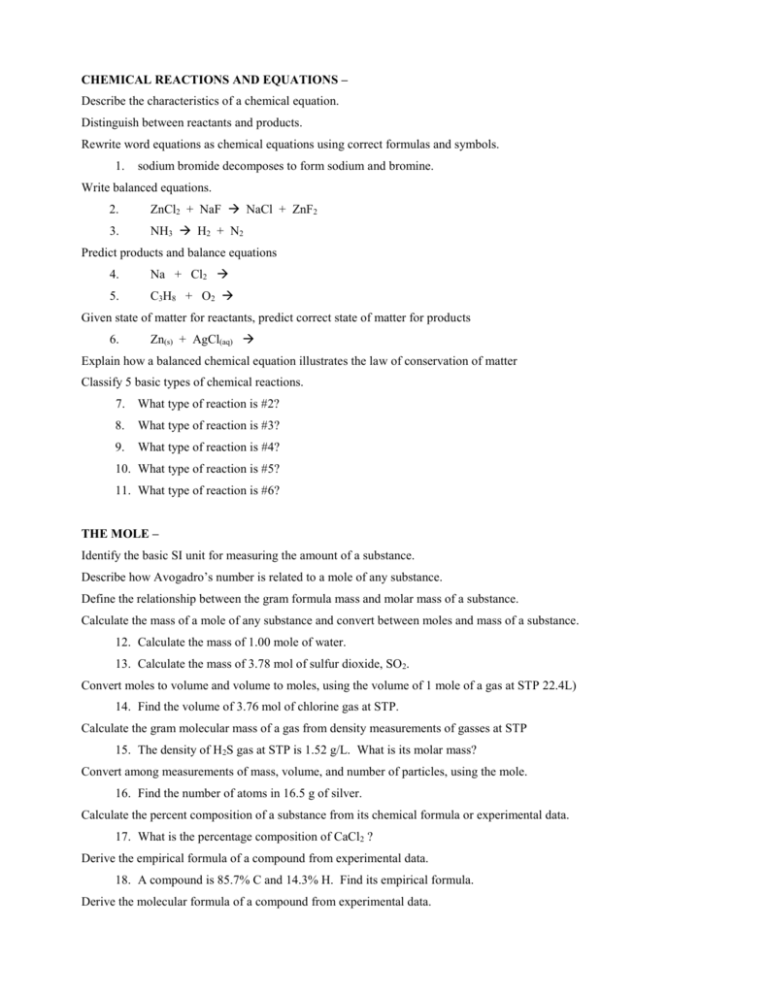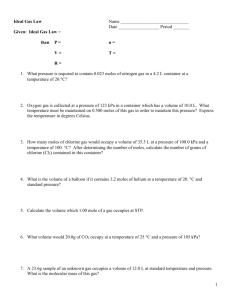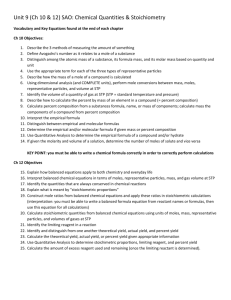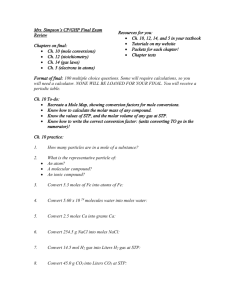CHEMICAL REACTIONS AND EQUATIONS – CHAPTER 9
advertisement

CHEMICAL REACTIONS AND EQUATIONS – Describe the characteristics of a chemical equation. Distinguish between reactants and products. Rewrite word equations as chemical equations using correct formulas and symbols. 1. sodium bromide decomposes to form sodium and bromine. Write balanced equations. 2. ZnCl2 + NaF NaCl + ZnF2 3. NH3 H2 + N2 Predict products and balance equations 4. Na + Cl2 5. C3H8 + O2 Given state of matter for reactants, predict correct state of matter for products 6. Zn(s) + AgCl(aq) Explain how a balanced chemical equation illustrates the law of conservation of matter Classify 5 basic types of chemical reactions. 7. What type of reaction is #2? 8. What type of reaction is #3? 9. What type of reaction is #4? 10. What type of reaction is #5? 11. What type of reaction is #6? THE MOLE – Identify the basic SI unit for measuring the amount of a substance. Describe how Avogadro’s number is related to a mole of any substance. Define the relationship between the gram formula mass and molar mass of a substance. Calculate the mass of a mole of any substance and convert between moles and mass of a substance. 12. Calculate the mass of 1.00 mole of water. 13. Calculate the mass of 3.78 mol of sulfur dioxide, SO2. Convert moles to volume and volume to moles, using the volume of 1 mole of a gas at STP 22.4L) 14. Find the volume of 3.76 mol of chlorine gas at STP. Calculate the gram molecular mass of a gas from density measurements of gasses at STP 15. The density of H2S gas at STP is 1.52 g/L. What is its molar mass? Convert among measurements of mass, volume, and number of particles, using the mole. 16. Find the number of atoms in 16.5 g of silver. Calculate the percent composition of a substance from its chemical formula or experimental data. 17. What is the percentage composition of CaCl2 ? Derive the empirical formula of a compound from experimental data. 18. A compound is 85.7% C and 14.3% H. Find its empirical formula. Derive the molecular formula of a compound from experimental data. 19. The gram molecular mass of the compound in the previous problem is 42.0 g. Find the molecular formula of the compound. THE MATHEMATICS OF CHEMICAL EQUATIONS – Define stoichiometry and describe its importance. Relate stoichiometry to balanced chemical equations. Interpret chemical equations in terms of molecules, moles, mass, and volume 20. 2H2(g) + O2(g) 2H2O(g) Construct mole ratios from balanced chemical equations and apply these ratios in calculating mole-mole stoichiometry problems. 21. Calculate the number of moles of water produced when 0 .750 moles of hydrogen reacts with oxygen. 2H2(g) + O2(g) 2H2O(g) Identify and solve different types of stochiometry. 22. Calculate the number of grams of H2SO4 produced when 25.0 grams of H 2O reacts with SO3. H2O(g) + SO3(g) H2SO4(g) Determine the limiting reactant of a chemical reaction. 23. What is the limiting reagent when 2.1 moles SO2 reacts with 3.7 moles of O2? 2 SO2(g) + O2(g) 2 SO3(g) Calculate the amount of product formed in a chemical reaction and calculate % yield. In a laboratory, 145 grams of NaClO was heated and produced 50.0 g of NaCl, according to the following equation. 2NaClO(s) 2NaCl(g) + 3O2(g) 24. What is the theoretical yield? 25. What is the percent yield? GASES – Describe the kinetic-molecular theory and explain how it accounts for observed behavior Explain what gas pressure means and describe how it is measured. Infer from observation the effect of changing the amount of gas in a container. Infer from observation the effect of changing the dimensions (size) of the container. Infer from kinetic theory the effect of temperature changes on a contained gas. Convert units of pressures State the gas laws. Boyle’s Law 26. A mass of air occupies a volume of 5.82 L at a pressure of 52.7 kPa. What is the new pressure if the same mass of air at the same temperature is transferred to a 2.00 L container? Charles’s Law 27. A volume of 20.0 L of O2 is warmed from -20.0°C to 85.0°C. What is the new volume if pressure is kept constant? Gay-Lussac Law 28. A rigid container holds a gas at a pressure of 53.5 kPa at a temperature of –100°C. What will the pressure be when the temperature is increased to 200°C? Combined Gas Law 29. What is the new volume of a sample of C02 at STP that has n original volume of 25.0 mL at 30.0°C and 680 mm Hg? Ideal Gas Law 30. What is the volume of a sample of O2 that has a mass of 45.0 g and is under a pressure of 120 kPa at 27.0°C? Dalton’s Law 31. Determine the total pressure of a gas mixture that contains CO, Ne, and He if the partial pressures of the gases are PCO = 125 kPa, PNe = 83 kPa, and PHe = 44 kPa. LIQUIDS AND SOLIDS – Explain how kinetic-molecular theory accounts for the physical properties of liquids and solids. Describe the different types of intermolecular forces. Define viscosity and surface tension and explain their relationship to intermolecular forces. Compare crystalline and amorphous substances. Relate the structure and bonding in the four categories of solids to the properties they exhibit. Describe vaporization, condensation, and boiling. Describe freezing and melting SOLUTIONS – Describe the properties of solutions. Identify the different types of solutions. Measure the concentration of solutions in terms of molarity, molality, and mole fraction. 32. Identify the solute and the solvent in a sample of air. 33. What is the Molarity of an aqueous solution that contains 10.0 g NaCl in a total volume of 755 mL of solution? 34. What is the molality of a solution containing 125 g of iodine and 750. g of carbon tetrachloride (CCl 4)? 35. A gas mixture contains 50.4 g of dinitrogen monoxide (N2O) and 65.2 g of oxygen gas. What is the mole fraction of dinitrogen monoxide? Define a colligative property of a solution. 36. What is the freezing point depression when 25.8 g of sodium chloride is dissolved in water to create 750. mL of total solution? Differentiate among saturated, unsaturated, and supersaturated solutions. Explain how solutions form. Define solubility and describe the factors that affect the rate at which a solid dissolves in a liquid and a gas dissolves in a liquid ACIDS, BASES, AND, SALTS – Identify the common physical and chemical properties of acids and bases State the Arrhenius definition of acids and bases. State the Bronsted-Lowry definition of acids and bases. Identify conjugate acid/base pairs. 37. NH3 + H2O NH4+ + OHExplain what dissociation constants indicate about an acid or base. Use experimental data to calculate a dissociation constant. Explain what most acidic hydrogen atoms have in common. Explain what most bases have in common. Describe how acids are named. REACTIONS OF ACIDS AND BASES – Identify the ion concentrations of H+ and OH- in pure water. Describe the pH scale. 38. Calculate [OH-] for water when [H3O+] = 4.2 x 10-9 M. In household bleach, the concentration of OH- ions is 5.0 x 10-2M. 39. What is the H+ concentration? 40. What is the pH? 41. Calculate [H3O+] for solutions with a pH of 5.52 Identify a buffer.







